Morphodynamic Behaviour of a Mediterranean Intermittent Estuary with Opening Phases Primarily Dominated by Offshore Winds
Abstract
1. Introduction
- More complex mechanisms coupling the impact of storm swell submergence with flooding generated by heavy precipitation (flash floods) [33,34]. These opening phases cause a wide redistribution of sediment in and around the inlet system [35]. The response to an event is not identical over time, and depends on the inherited topographic state [36], itself linked to processes operating on event scales up to several decades [31];
- Cross-shore transport, when the swell is able to remobilize sediments in the surrounding area or in the nearshore bars, which then nourish the sub-aerial beach and fill the outlet. This shoreline feeding mechanism is commonly evoked in the case of long-period swells with frontal incidence coupled with a low longshore transport rate and low outflow velocities <0.1 m.s−1 [4,12,19,37,39,40,41];
2. Study Site
- Dominant offshore winds (NW) blowing 70% of the time, commonly reaching daily average speeds above 10 m.s−1 and even 30 m.s−1 for a few hours (gusts > 40 m.s−1), with between 10 and 30 days average wind speed above 27 m.s−1 [57]. This violent and cold offshore wind blows from the west along the foothills of the Pyrenees and the southern mountains of the Massif Central. Two meteorological situations classically generate this wind, either an anticyclonic zone between Spain and the SW of France or an N/NW flow often in the form of a cold front bringing cold air to the Mediterranean between a high-pressure area in the west and a low-pressure area in the east located on the Gulf of Genoa or the Tyrrhenian Sea [58]. This offshore wind regime generates seaward-directed waves that have no impact on our study site.
- Onshore winds are the least frequent (30% of the time) and can be accompanied by swell; these winds are associated with severe winter storm events [59]. The S/SE swell, associated with onshore winds, is characterized by significant wave height (Hs) of 2.5 m for annual storms and up to 6 m for a decadal storm, with a period (Ts) of around 5 to 10 s [56]. Here, a storm is defined as a wave event in which Hs exceeds a threshold value of 2 m [60,61]. A seasonality is observable in the wind regime, with severe offshore wind events from late autumn through to spring interspersed by marine storm events, and with low-intensity sea breezes during the summer [56]. Spring and summer are characterized by low-energy conditions, whereas autumn and winter are more energetic periods [59,62]. Longshore drift is locally directed to the north [56,63].
3. Materials and Methods
3.1. Topographic Survey
3.2. Hydrodynamic Measurements
3.3. Meteorology
4. Results
4.1. Hydrodynamics and Water-Level Variations according to Prevailing Meteorological Forcings
4.2. Morphological Evolution Associated with Prevailing Meteorological Forcings (2017–2022)
Morphological Evolution during Offshore Wind Forcing
- The general morphodynamics of the beach under offshore wind conditions
- Major opening phases
- Secondary opening phases
- Morphological evolution during onshore forcing
- Low-energy conditions (Hs < 2 m)
- High-energy conditions (Hs > 2 m)
5. Discussion
5.1. Morphodynamic Model of an Intermittent Microtidal Inlet
5.1.1. Early Autumn, Beginning of the Annual Cycle with Lagoonal Impounding, and Increasing System Energy
5.1.2. Late Autumn, the First Major Opening of the Inlet
5.1.3. Inlet Dynamics over the Winter Period
5.1.4. Response to Easterly Winter Storms
- The inlet is closed when the storm occurs and strong flooding can lead to breaching of the beach barrier (Figure 11f). However, this phenomenon is rare (only 1 of the 27 openings observed during our monitoring period). The exact moment of the rupture is not well identified, but it is strongly linked to the large quantities of sea water filling the lagoon and the submergence of the barrier;
- The inlet remains closed if conditions are not dynamic enough to cause a breach. In this case, the inflow of water will fill the lagoon and lead to flooding of the barrier which may facilitate a future opening during offshore winds in the following days or weeks;
- The inlet is already open at the time of the storm, in which case it will be deepened and widened by currents generated by storm surge action, flooding, or possible watershed discharge usually associated with cyclonic storms (Figure 11e);
5.1.5. Spring, Last Closure at the End of the Annual Cycle with Decreasing System Energy
5.1.6. Summer, Evolution under Low-Energy Hydrodynamic Conditions
5.2. Comparison of Control Parameters Commonly Accepted in the Literature
5.3. Formation of Several Inlets and Self-Organization to a Single Active Inlet
6. Conclusions
- The accumulation of lagoon waters behind the sandy barrier that makes up the beach;
- The lowering of the berm by wind deflation during intense offshore wind events and the export of sand to nearshore areas, highlighting the importance of exchanges at the coastline;
- The surge of lagoon waters behind the beach barrier during offshore wind events;
- The position of nearshore bars, which will create areas of lower elevation of the berm in connection with beach megacusp horns;
- Storms which can very occasionally lead to openings of the inlet concomitant with an overall retreat of the barrier, in contrast to the much more frequent openings related to offshore winds. However, the study does not address in detail the processes of syn-opening, to do so would require specific instrumentation and over significant periods of time.
Author Contributions
Funding
Institutional Review Board Statement
Informed Consent Statement
Data Availability Statement
Acknowledgments
Conflicts of Interest
References
- Behrens, D.K.; Bombardelli, F.A.; Largier, J.L.; Twohy, E. Episodic Closure of the Tidal Inlet at the Mouth of the Russian River—A Small Bar-Built Estuary in California. Geomorphology 2013, 189, 66–80. [Google Scholar] [CrossRef]
- Haines, P.E.; Tomlinson, R.B.; Thom, B.G. Morphometric Assessment of Intermittently Open/Closed Coastal Lagoons in New South Wales, Australia. Estuar. Coast. Shelf Sci. 2006, 67, 321–332. [Google Scholar] [CrossRef]
- Orescanin, M.M.; Scooler, J. Observations of Episodic Breaching and Closure at an Ephemeral River. Cont. Shelf Res. 2018, 166, 77–82. [Google Scholar] [CrossRef]
- Ranasinghe, R.; Pattiaratchi, C.; Masselink, G. A Morphodynamic Model to Simulate the Seasonal Closure of Tidal Inlets. Coast. Eng. 1999, 37, 1–36. [Google Scholar] [CrossRef]
- Cooper, J.A.G. Geomorphological Variability among Microtidal Estuaries from the Wave-Dominated South African Coast. Geomorphology 2001, 40, 99–122. [Google Scholar] [CrossRef]
- FitzGerald, D.M. Geomorphic Variability and Morphologic and Sedimentologic Controls on Tidal Inlets. J. Coast. Res. 1996, 23, 47–72. [Google Scholar]
- McSweeney, S.L.; Kennedy, D.M.; Rutherfurd, I.D.; Stout, J.C. Intermittently Closed/Open Lakes and Lagoons: Their Global Distribution and Boundary Conditions. Geomorphology 2017, 292, 142–152. [Google Scholar] [CrossRef]
- Sadat-Noori, M.; Santos, I.R.; Tait, D.R.; McMahon, A.; Kadel, S.; Maher, D.T. Intermittently Closed and Open Lakes and/or Lagoons (ICOLLs) as Groundwater-Dominated Coastal Systems: Evidence from Seasonal Radon Observations. J. Hydrol. 2016, 535, 612–624. [Google Scholar] [CrossRef]
- Becker, A.; Laurenson, L.J.B.; Bishop, K. Artificial Mouth Opening Fosters Anoxic Conditions That Kill Small Estuarine Fish. Estuar. Coast. Shelf Sci. 2009, 82, 566–572. [Google Scholar] [CrossRef]
- Hayes, S.A.; Bond, M.H.; Hanson, C.V.; Freund, E.V.; Smith, J.J.; Anderson, E.C.; Ammann, A.J.; MacFarlane, R.B. Steelhead Growth in a Small Central California Watershed: Upstream and Estuarine Rearing Patterns. Trans. Am. Fish. Soc. 2008, 137, 114–128. [Google Scholar] [CrossRef]
- Davidson, M.A.; Morris, B.D.; Turner, I.L. A Simple Numerical Model for Inlet Sedimentation at Intermittently Open–Closed Coastal Lagoons. Cont. Shelf Res. 2009, 29, 1975–1982. [Google Scholar] [CrossRef]
- Ranasinghe, R.; Pattiaratchi, C. The Seasonal Closure of Tidal Inlets: Causes and Effects. Coast. Eng. J. 2003, 45, 601–627. [Google Scholar] [CrossRef]
- Riddin, T.; Adams, J.B. Influence of Mouth Status and Water Level on the Macrophytes in a Small Temporarily Open/Closed Estuary. Estuar. Coast. Shelf Sci. 2008, 79, 86–92. [Google Scholar] [CrossRef]
- Behrens, D.K.; Bombardelli, F.A.; Largier, J.L.; Twohy, E. Characterization of Time and Spatial Scales of a Migrating Rivermouth. Geophys. Res. Lett. 2009, 36. [Google Scholar] [CrossRef]
- Hinwood, J.B.; McLean, E.J. Multi-Factor Tracking of Tidal Processes in an Intermittently Open Estuarine Lake. Geomorphology 2022, 415, 108400. [Google Scholar] [CrossRef]
- James, G.W. Surface Water Dynamics at the Carmel Lagoon Water Years 1991 through 2005; Monterey Peninsula Water Management Agency: Monterey, CA, USA, 2005; p. 152. [Google Scholar]
- McSweeney, S.L.; Kennedy, D.M.; Rutherfurd, I.D. The Daily-Scale Entrance Dynamics of Intermittently Open/Closed Estuaries. Earth Surf. Process. Landf. 2017, 43, 791–807. [Google Scholar] [CrossRef]
- Seminack, C.T.; McBride, R.A. A Life-Cycle Model for Wave-Dominated Tidal Inlets along Passive Margin Coasts of North America. Geomorphology 2018, 304, 141–158. [Google Scholar] [CrossRef]
- Bertin, X.; Mendes, D.; Martins, K.; Fortunato, A.B.; Lavaud, L. The Closure of a Shallow Tidal Inlet Promoted by Infragravity Waves. Geophys. Res. Lett. 2019, 46, 6804–6810. [Google Scholar] [CrossRef]
- McSweeney, S.L.; Stout, J.C.; Kennedy, D.M. Variability in Infragravity Wave Processes during Estuary Artificial Entrance Openings. Earth Surf. Process. Landf. 2020, 45, 3414–3428. [Google Scholar] [CrossRef]
- Melito, L.; Postacchini, M.; Sheremet, A.; Calantoni, J.; Zitti, G.; Darvini, G.; Penna, P.; Brocchini, M. Hydrodynamics at a Microtidal Inlet: Analysis of Propagation of the Main Wave Components. Estuar. Coast. Shelf Sci. 2020, 235, 106603. [Google Scholar] [CrossRef]
- Melito, L.; Postacchini, M.; Sheremet, A.; Calantoni, J.; Zitti, G.; Darvini, G.; Brocchini, M. Wave-Current Interactions and Infragravity Wave Propagation at a Microtidal Inlet. Proceedings 2018, 2, 628. [Google Scholar] [CrossRef]
- Harvey, M.E.; Giddings, S.N.; Pawlak, G.; Crooks, J.A. Hydrodynamic Variability of an Intermittently Closed Estuary over Interannual, Seasonal, Fortnightly, and Tidal Timescales. Estuaries Coasts 2022. [Google Scholar] [CrossRef]
- Bertin, X.; Fortunato, A.; Oliveira, A. Morphodynamic Modeling of the Ancão Inlet, South Portugal. J. Coast. Res. Spec. Issue 2009, 56, 10–14. [Google Scholar]
- Dodet, G.; Bertin, X.; Bruneau, N.; Fortunato, A.B.; Nahon, A.; Roland, A. Wave-Current Interactions in a Wave-Dominated Tidal Inlet. J. Geophys. Res. Ocean. 2013, 118, 1587–1605. [Google Scholar] [CrossRef]
- Orescanin, M.; Raubenheimer, B.; Elgar, S. Observations of Wave Effects on Inlet Circulation. Cont. Shelf Res. 2014, 82, 37–42. [Google Scholar] [CrossRef]
- Hayes, M.O.; FitzGerald, D.M. Origin, Evolution, and Classification of Tidal Inlets. J. Coast. Res. 2013, 69, 14–33. [Google Scholar] [CrossRef]
- Rich, A.; Keller, E.A. A Hydrologic and Geomorphic Model of Estuary Breaching and Closure. Geomorphology 2013, 191, 64–74. [Google Scholar] [CrossRef]
- Kraus, N.C.; Patsch, K.; Munger, S. Barrier Beach Breaching from the Lagoon Side, with Reference to Northern California. Shore Beach 2008, 76, 12. [Google Scholar]
- Zietsman, I. Hydrodynamics of Temporary Open Estuaries, with Case Studies of Mhlanga and Mdloti. Master Thesis, University of Natal, Durban, South Africa, 2004. [Google Scholar]
- Robin, N.; Levoy, F.; Anthony, E.J.; Monfort, O. Sand Spit Dynamics in a Large Tidal-range Environment: Insight from Multiple LiDAR, UAV and Hydrodynamic Measurements on Multiple Spit Hook Development, Breaching, Reconstruction, and Shoreline Changes. Earth Surf. Process. Landf. 2020, 45, esp.4924. [Google Scholar] [CrossRef]
- Gharagozlou, A.; Anderson, D.L.; Gorski, J.F.; Dietrich, J.C. Emulator for Eroded Beach and Dune Profiles due to Storms. J. Geophys. Res. Earth Surf. 2022, 127, e2022JF006620. [Google Scholar] [CrossRef]
- Balouin, Y.; Bourrin, F.; Meslard, F.; Palvadeau, E.; Robin, N. Assessing the Role of Storm Waves and River Discharge on Sediment Bypassing Mechanisms at the Têt River Mouth in the Mediterranean (Southeast France). J. Coast. Res. 2020, 95, 351. [Google Scholar] [CrossRef]
- Meslard, F.; Balouin, Y.; Robin, N.; Bourrin, F. Assessing the Role of Extreme Mediterranean Events on Coastal River Outlet Dynamics. Water 2022, 14, 2463. [Google Scholar] [CrossRef]
- Warrick, J.A. Littoral Sediment From Rivers: Patterns, Rates and Processes of River Mouth Morphodynamics. Front. Earth Sci. 2020, 8, 355. [Google Scholar] [CrossRef]
- Donnelly, C. Morphologic Change by Overwash: Establishing and Evaluating Predictors. J. Coast. Res. 2007, 50, 520–526. [Google Scholar]
- FitzGerald, D.M.; Buynevich, I.V. Tidal Inlets and Deltas. In Sedimentology; Springer: Dordrecht, The Netherlands, 2003; pp. 1219–1224. ISBN 978-1-4020-3609-5. [Google Scholar]
- Nienhuis, J.H.; Ashton, A.D. Mechanics and Rates of Tidal Inlet Migration: Modeling and Application to Natural Examples: Inlet Migration. J. Geophys. Res. Earth Surf. 2016, 121, 2118–2139. [Google Scholar] [CrossRef]
- Cooper, J.A.G. Sedimentary Processes in the River-Dominated Mvoti Estuary, South Africa. Geomorphology 1994, 9, 271–300. [Google Scholar] [CrossRef]
- FitzGerald, D.M. Shoreline Erosional-Depositional Processes Associated with Tidal Inlets; Aubrey, D.G., Weishar, L., Eds.; Springer: New York, NY, USA, 1988; pp. 186–225. [Google Scholar]
- Hayes, M.O. Geomorphology and Sedimentation Patterns of Tidal Inlets: A Review; ASCE Seattle: Washington, DC, USA, 1991; pp. 1343–1355. [Google Scholar]
- Deng, J.; Jones, B.G.; Rogers, K.; Woodroffe, C.D. Wind Influence on the Orientation of Estuarine Landforms: An Example from Lake Illawarra in Southeastern Australia. Earth Surf. Process. Landf. 2018, 43, 2915–2925. [Google Scholar] [CrossRef]
- Hunt, S.; Bryan, K.R.; Mullarney, J.C. The Influence of Wind and Waves on the Existence of Stable Intertidal Morphology in Meso-Tidal Estuaries. Geomorphology 2015, 228, 158–174. [Google Scholar] [CrossRef]
- Alekseenko, E.; Roux, B.; Sukhinov, A.; Kotarba, R.; Fougere, D. Coastal Hydrodynamics in a Windy Lagoon. Comput. Fluids 2013, 77, 24–35. [Google Scholar] [CrossRef]
- Boutron, O.; Bertrand, O.; Fiandrino, A.; Höhener, P.; Sandoz, A.; Chérain, Y.; Coulet, E.; Chauvelon, P. An Unstructured Numerical Model to Study Wind-Driven Circulation Patterns in a Managed Coastal Mediterranean Wetland: The Vaccarès Lagoon System. Water 2015, 7, 5986–6016. [Google Scholar] [CrossRef]
- Leredde, Y.; Dekeyser, I.; Devenon, J.-L. T-S Data Assimilation to Optimise Turbulent Viscosity: An Application to the Berre Lagoon Hydrodynamics. J. Coast. Res. 2002, 18, 555–567. [Google Scholar]
- Paugam, C.; Sous, D.; Rey, V.; Meulé, S. Field Study of Wind Tide Semi-Enclosed Shallow Basins. Coast. Eng. Proc. 2020, 36, 27. [Google Scholar] [CrossRef]
- Paugam, C.; Sous, D.; Rey, V.; Meulé, S.; Faure, V.; Boutron, O.; Luna-Laurent, E.; Migne, E. Wind Tides and Surface Friction Coefficient in Semi-Enclosed Shallow Lagoons. Estuar. Coast. Shelf Sci. 2021, 257, 107406. [Google Scholar] [CrossRef]
- Bauer, B.O.; Davidson-Arnott, R.G.D.; Walker, I.J.; Hesp, P.A.; Ollerhead, J. Wind Direction and Complex Sediment Transport Response across a Beach–Dune System. Earth Surf. Process. Landf. 2012, 37, 1661–1677. [Google Scholar] [CrossRef]
- Gares, P.A.; Davidson-Arnott, R.G.D.; Bauer, B.O.; Sherman, D.J.; Carter, R.W.G.; Jackson, D.W.T.; Nordstromt, K.F. Aeolian Sediment Transport Under Offshore Wind Conditions: Implications for Aeolian Sediment Budget Calculations. J. Coast. Res. 1996, 12, 673–682. [Google Scholar]
- Nordstrom, K.F.; Bauer, B.O.; Davidson-Arnott, R.G.D.; Garesc, P.A.; Carter, R.W.G.; Jackson, D.W.T.; Sherman, D.J. Offshore Aeolian Transport Across a Beach: Carrick Finn Strand, Ireland. J. Coast. Res. 1996, 664–672. [Google Scholar]
- Nordstrom, K.F.; Jackson, N.L. Offshore Aeolian Sediment Transport across a Human-Modified Foredune. Earth Surf. Process. Landf. 2017, 43, 195–201. [Google Scholar] [CrossRef]
- Law, M.N.; Davidson-Arnott, R. Seasonal Controls on Aeolian Processes on the Beach and Foredune. Proc. Symp. Coast. Sand Dunes 1990, 49–68. [Google Scholar]
- Sabatier, F.; Chaïbi, M.; Chauvelon, P. Transport éolien par vent de mer et al.imentation sédimentaire des dunes de Camargue. Mediterranee 2007, 108, 83–90. [Google Scholar] [CrossRef]
- Sabatier, F.; Samat, O.; Chaibi, M.; Lambert, A.; Pons, F. Transport Sédimentaire de La Dune à La Zone Du Déferlement Sur Une Plage Sableuse Soumise à Des Vents de Terre. In Proceedings of the VIIIèmes Journées Nationales Génie Civil—Génie Côtier, Compiègne, France, 7–9 September 2004. [Google Scholar]
- Certain, R. Morphodynamique d’une côte Sableuse Microtidale à Barres: Le Golfe du Lion (Languedoc-Roussillon). Ph.D. Thesis, Université de Perpignan, Perpignan, France, 2002. [Google Scholar]
- Infoclimat Leucate (Aude—France)|Relevés Météo En Temps Réel—Infoclimat. Available online: https://www.infoclimat.fr/observations-meteo/temps-reel/leucate/07666.html?graphiques (accessed on 10 August 2022).
- Mayençon, R. Météorologie Marine; Editions Maritimes D’outre mer: Paris, France, 1992; ISBN 978-2-7373-0716-4. [Google Scholar]
- Aleman, N.; Robin, N.; Certain, R.; Anthony, E.J.; Barusseau, J.P. Longshore Variability of Beach States and Bar Types in a Microtidal, Storm-Influenced, Low-Energy Environment. Geomorphology 2015, 241, 175–191. [Google Scholar] [CrossRef]
- Aleman, N.; Robin, N.; Certain, R.; Vanroye, C.; Barusseau, J.P.; Bouchette, F. Typology of Nearshore Bars in the Gulf of Lions (France) Using LIDAR Technology. J. Coast. Res. 2011, 64, 721–725. [Google Scholar]
- Mendoza, E.; Jiménez, J. Storm-Induced Beach Erosion Potential on the Catalonian Coast. J. Coast. Res. SI 2006, 48, 81–88. [Google Scholar]
- Cerema; Dreal, L.R. Fiche Synthétique de la Campagne 01001 Leucate; Cerema: Bron, France, 2018; p. 9. [Google Scholar]
- Kulling, B. Déformation du Rivage et Dérive Littorale des Plages du Golfe du Lion. Ph.D. Thesis, Université d’Aix-Marseille, Marseille, France, 2017. [Google Scholar]
- PNRNM Carte Du Fonctionnement Hydrologique de l’étang de La Palme 2010; Parc naturel régional de la Narbonnaise en Méditerranée: Sigean, France, 2010.
- Anselme, B.; Goeldner-Gianella, L.; Durand, P. Le Risque de Submersion Dans Le Système Lagunaire de La Palme (Languedoc, France): Nature de l’aléa et Perception Du Risque. In Proceedings of the Colloque International Pluridisciplinaire, Les littoraux: Subir, Dire et agir, Lille, France, 16–18 January 2008. [Google Scholar]
- Larue, J.-P.; Rouquet, J. La lagune de La Palme (Aude, France) face au comblement et à l’eutrophisation. Physio-Géo. Géographie Phys. Environ. 2016, 10, 45–60. [Google Scholar] [CrossRef]
- Fiandrino, A.; Giraud, A.; Robin, S.; Pinatel, C. Validation D’une Méthode D’estimation des Volumes D’eau Echangés Entre la mer et les Lagunes. 2012, p. 104. Available online: https://archimer.ifremer.fr/doc/00274/38544/37064.pdf (accessed on 1 April 2019).
- Rodellas, V.; Stieglitz, T.C.; Andrisoa, A.; Cook, P.G.; Raimbault, P.; Tamborski, J.J.; van Beek, P.; Radakovitch, O. Groundwater-Driven Nutrient Inputs to Coastal Lagoons: The Relevance of Lagoon Water Recirculation as a Conveyor of Dissolved Nutrients. Sci. Total Environ. 2018, 642, 764–780. [Google Scholar] [CrossRef] [PubMed]
- Wilke, M.; Boutière, H. Hydrobiological, physical and chemical characteristics and spatio-temporal dynamics of an oligotrophic mediterranean lagoon: The etang de La Palme (France). Vie Et Milieu 2000, 50, 101–115. [Google Scholar]
- Ferrer, P. Morphodynamique à Multi-Echelles du Trait de Côte (Prisme Sableux) du Golfe du Lion Depuis le Dernier Optimum Climatique. Ph.D. Thesis, Université de Perpignan Via Domitia, Perpignan, France, 2010. [Google Scholar]
- Aleman, N. Morphodynamique à l’échelle Régionale d’une Avant-Côte Microtidale à Barres Sédimentaires. Le cas du Languedoc-Roussillon à l’aide de la Technologie LIDAR. Ph.D. Thesis, Université de Perpignan Via Domitia, Perpignan, France, 2013. [Google Scholar]
- Cerema; Dreal, L.R. Observatoire Océanologique de Banyuls CANDHIS—Détail de La Campagne 01101—Leucate. Available online: http://candhis.cetmef.developpement-durable.gouv.fr/campagne/?idcampagne=c81e728d9d4c2f636f067f89cc14862c (accessed on 1 April 2019).
- Stockdon, H.F.; Holman, R.A.; Howd, P.A.; Sallenger, A.H. Empirical Parameterization of Setup, Swash, and Runup. Coast. Eng. 2006, 53, 573–588. [Google Scholar] [CrossRef]
- Castelle, B.; Marieu, V.; Bujan, S.; Splinter, K.D.; Robinet, A.; Sénéchal, N.; Ferreira, S. Impact of the Winter 2013–2014 Series of Severe Western Europe Storms on a Double-Barred Sandy Coast: Beach and Dune Erosion and Megacusp Embayments. Geomorphology 2015, 238, 135–148. [Google Scholar] [CrossRef]
- Castelle, B.; Scott, T.; Brander, R.; Mccarroll, R. Rip Current Types, Circulation and Hazard. Earth-Sci. Rev. 2016, 163, 1–21. [Google Scholar] [CrossRef]
- Thornton, E.B.; MacMahan, J.; Sallenger, A.H. Rip Currents, Mega-Cusps, and Eroding Dunes. Mar. Geol. 2007, 240, 151–167. [Google Scholar] [CrossRef]
- Masselink, G.; Pattiaratchi, C.B. Seasonal Changes in Beach Morphology along the Sheltered Coastline of Perth, Western Australia. Mar. Geol. 2001, 172, 243–263. [Google Scholar] [CrossRef]
- Roy, P.S.; Williams, R.J.; Jones, A.R.; Yassini, I.; Gibbs, P.J.; Coates, B.; West, R.J.; Scanes, P.R.; Hudson, J.P.; Nichol, S. Structure and Function of South-East Australian Estuaries. Estuar. Coast. Shelf Sci. 2001, 53, 351–384. [Google Scholar] [CrossRef]
- Stretch, D.; Parkinson, M. The Breaching of Sand Barriers at Perched, Temporary Open/Closed Estuaries—A Model Study. Coast. Eng. J. 2006, 48, 13–30. [Google Scholar] [CrossRef]
- Tagliapietra, D.; Sigovini, M.; Ghirardini, A.V. A Review of Terms and Definitions to Categorise Estuaries, Lagoons and Associated Environments. Mar. Freshw. Res. 2009, 60, 497–509. [Google Scholar] [CrossRef]
- Kennedy, D.M.; McSweeney, S.L.; Mariani, M.; Zavadil, E. The Geomorphology and Evolution of Intermittently Open and Closed Estuaries in Large Embayments in Victoria, Australia. Geomorphology 2020, 350, 106892. [Google Scholar] [CrossRef]
- Ranasinghe, R.; Pattiaratchi, C. The Seasonal Closure of Tidal Inlets: Wilson Inlet—A Case Study. Coast. Eng. 1999, 37, 37–56. [Google Scholar] [CrossRef]
- Cooper, J.A.G. Lagoons and Microtidal Coasts. In Coastal Evolution Late Quaternary Shoreline Morphodynamics; Carter, R.W.G., Woodroffe, C.D., Eds.; Cambridge University Press: Cambridge, UK, 1994; pp. 219–266. [Google Scholar] [CrossRef]
- Ranasinghe, R.; Pattiaratchi, C. Tidal Inlet Velocity Asymmetry in Diurnal Regimes. Cont. Shelf Res. 2000, 20, 2347–2366. [Google Scholar] [CrossRef]
- Wright, L.D.; Short, A.D. Morphodynamic Variability of Surf Zones and Beaches: A Synthesis. Mar. Geol. 1984, 56, 93–118. [Google Scholar] [CrossRef]
- González-Villanueva, R.; Pérez-Arlucea, M.; Costas, S. Lagoon Water-Level Oscillations Driven by Rainfall and Wave Climate. Coast. Eng. 2017, 130, 34–45. [Google Scholar] [CrossRef]
- Baldock, T.E.; Birrien, F.; Atkinson, A.; Shimamoto, T.; Wu, S.; Callaghan, D.P.; Nielsen, P. Morphological Hysteresis in the Evolution of Beach Profiles under Sequences of Wave Climates—Part 1; Observations. Coast. Eng. 2017, 128, 92–105. [Google Scholar] [CrossRef]
- Morris, B.D.; Turner, I.L. Morphodynamics of Intermittently Open–Closed Coastal Lagoon Entrances: New Insights and a Conceptual Model. Mar. Geol. 2010, 271, 55–66. [Google Scholar] [CrossRef]
- Brunel, C.; Certain, R.; Sabatier, F.; Robin, N.; Barusseau, J.P.; Aleman, N.; Raynal, O. 20th Century Sediment Budget Trends on the Western Gulf of Lions Shoreface (France): An Application of an Integrated Method for the Study of Sediment Coastal Reservoirs. Geomorphology 2014, 204, 625–637. [Google Scholar] [CrossRef]
- Coco, G.; Huntley, D.A.; O’Hare, T.J. Investigation of a Self-Organization Model for Beach Cusp Formation and Development. J. Geophys. Res. Ocean. 2000, 105, 21991–22002. [Google Scholar] [CrossRef]
- Coco, G.; Burnet, T.K.; Werner, B.T. Test of Self-Organization in Beach Cusp Formation. J. Geophys. Res. Earth Surf. 2003, 108, 3101. [Google Scholar] [CrossRef]
- Falqués, A.; Ribas, F.; Idier, D.; Arriaga, J. Formation Mechanisms for Self-Organized Km-Scale Shoreline Sand Waves: Self-Organized Shoreline Sand Waves. J. Geophys. Res. Earth Surf. 2017, 122, 1121–1138. [Google Scholar] [CrossRef]
- Caballeria, M.; Coco, G.; Falqués, A.; Huntley, D.A. Self-Organization Mechanisms for the Formation of Nearshore Crescentic and Transverse Sand Bars. J. Fluid Mech. 2002, 465, 379–410. [Google Scholar] [CrossRef]
- Coco, G.; Caballeria, M.; Falqués, A.; Huntley, D. Crescentic Bars and Nearshore Self-Organization Processes. J. Fluid Mech. 2002, 465, 379–410. [Google Scholar] [CrossRef]
- Coco, G.; Murray, A.B. Patterns in the Sand: From Forcing Templates to Self-Organization. Geomorphology 2007, 91, 271–290. [Google Scholar] [CrossRef]
- Fagherazzi, S. Self-Organization of Tidal Deltas. Proc. Natl. Acad. Sci. USA 2008, 105, 18692–18695. [Google Scholar] [CrossRef] [PubMed]
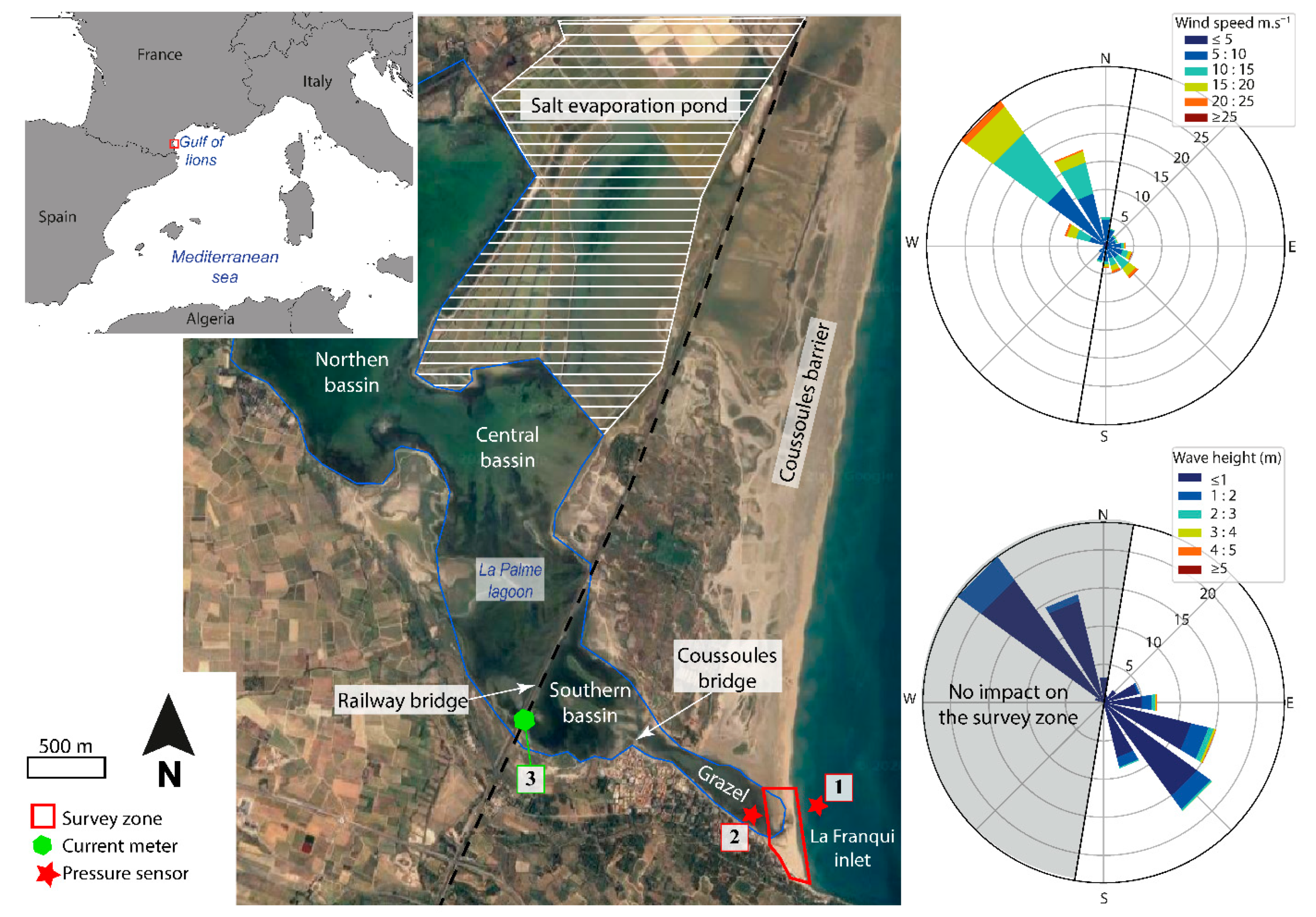
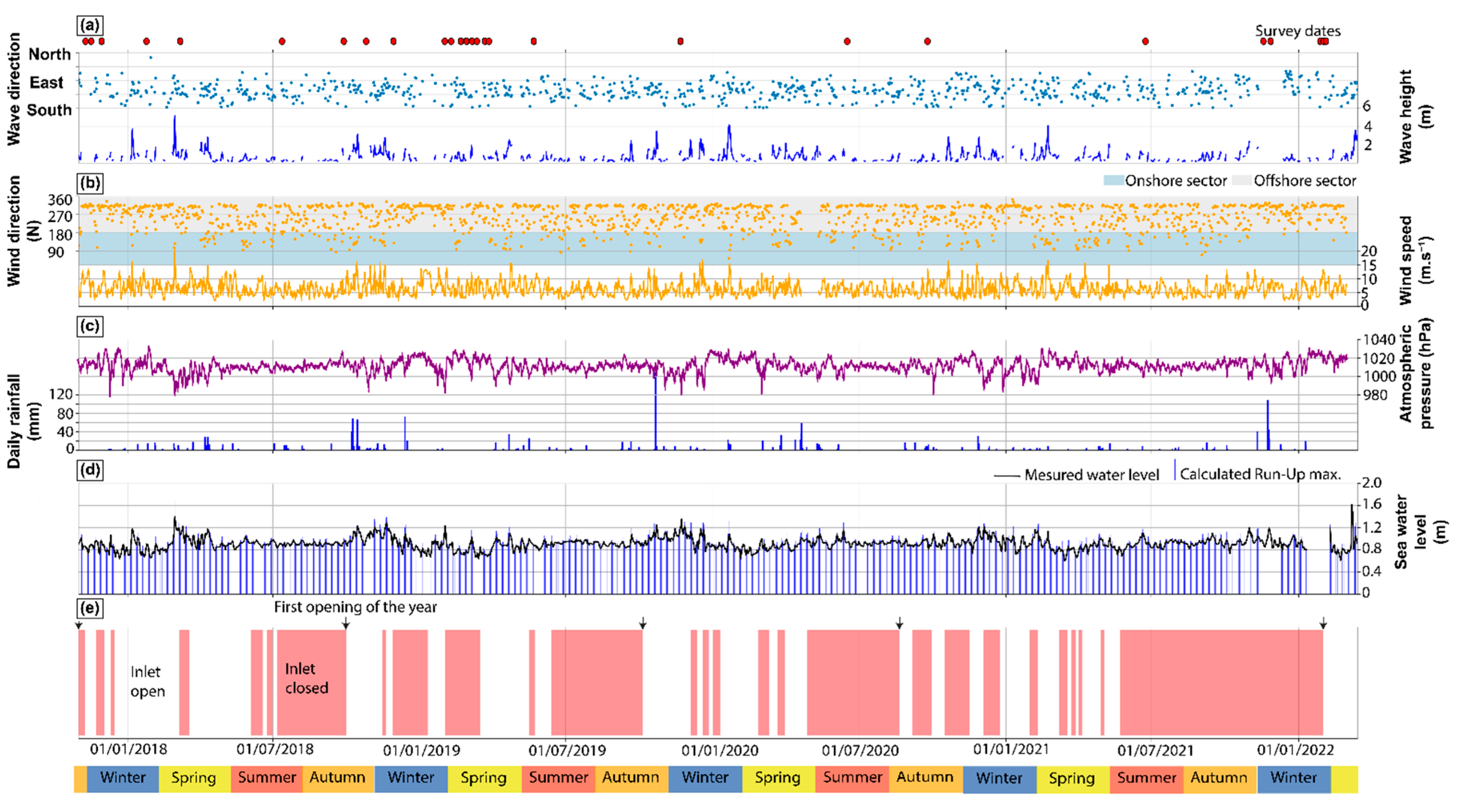

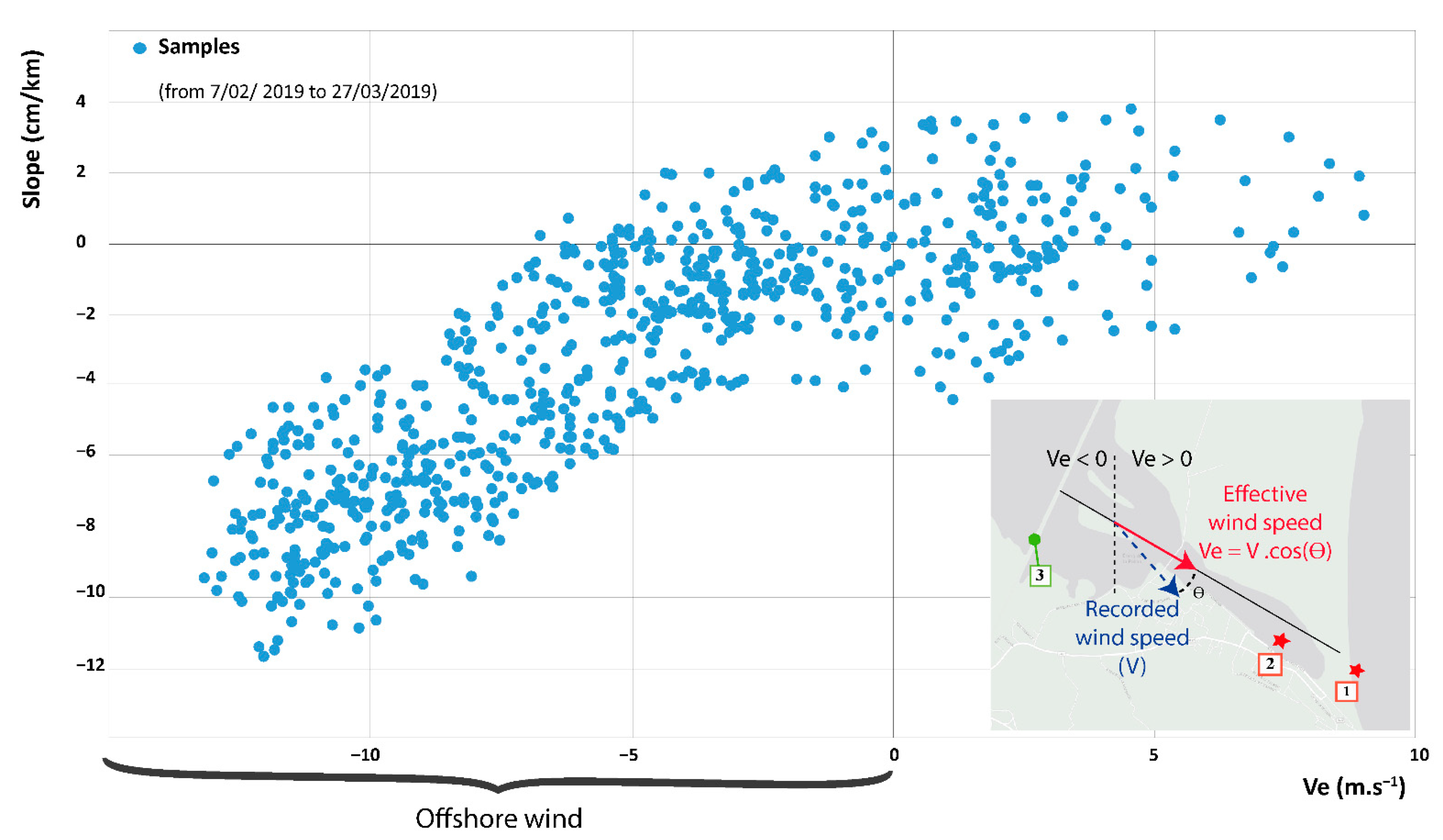
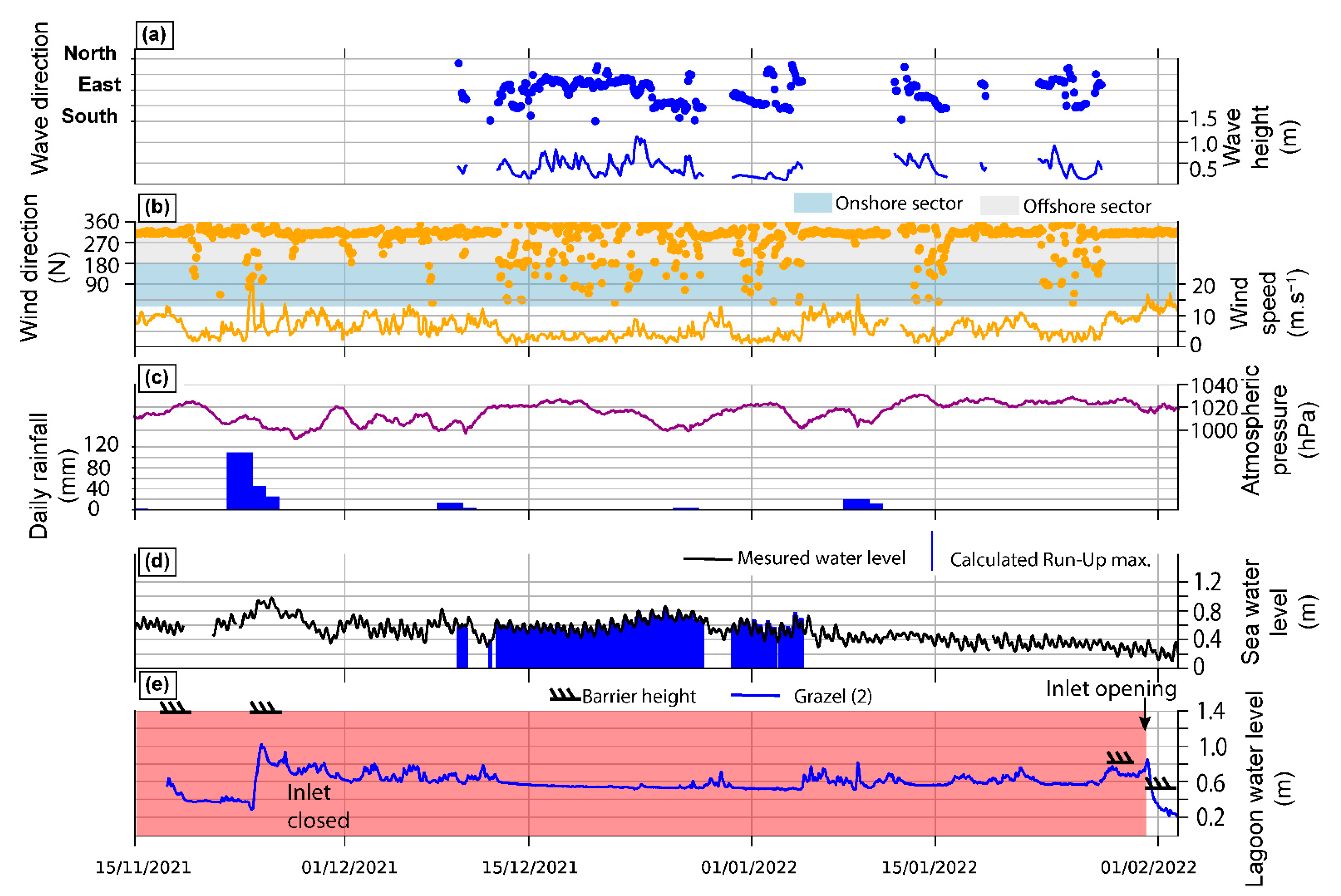



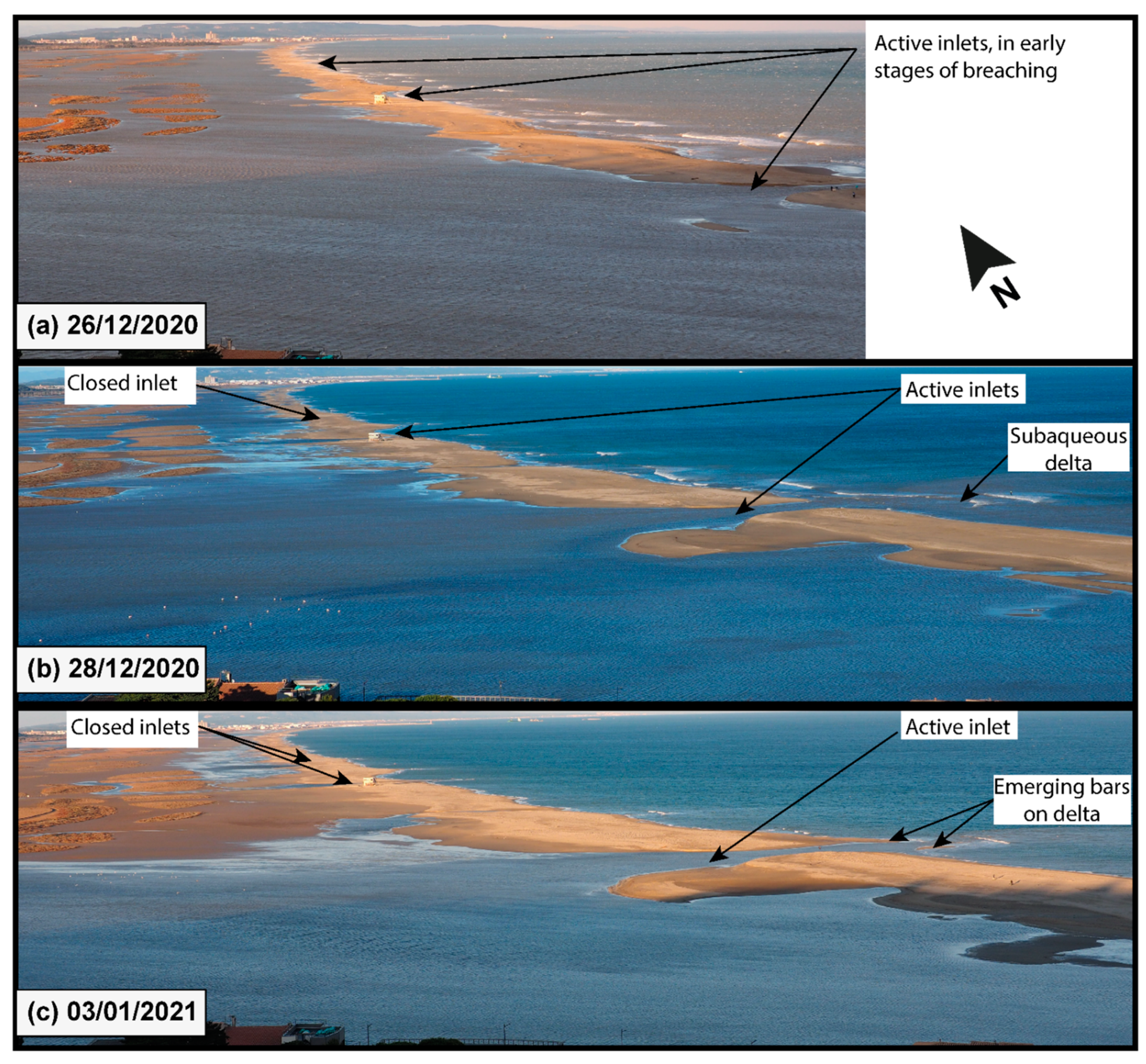
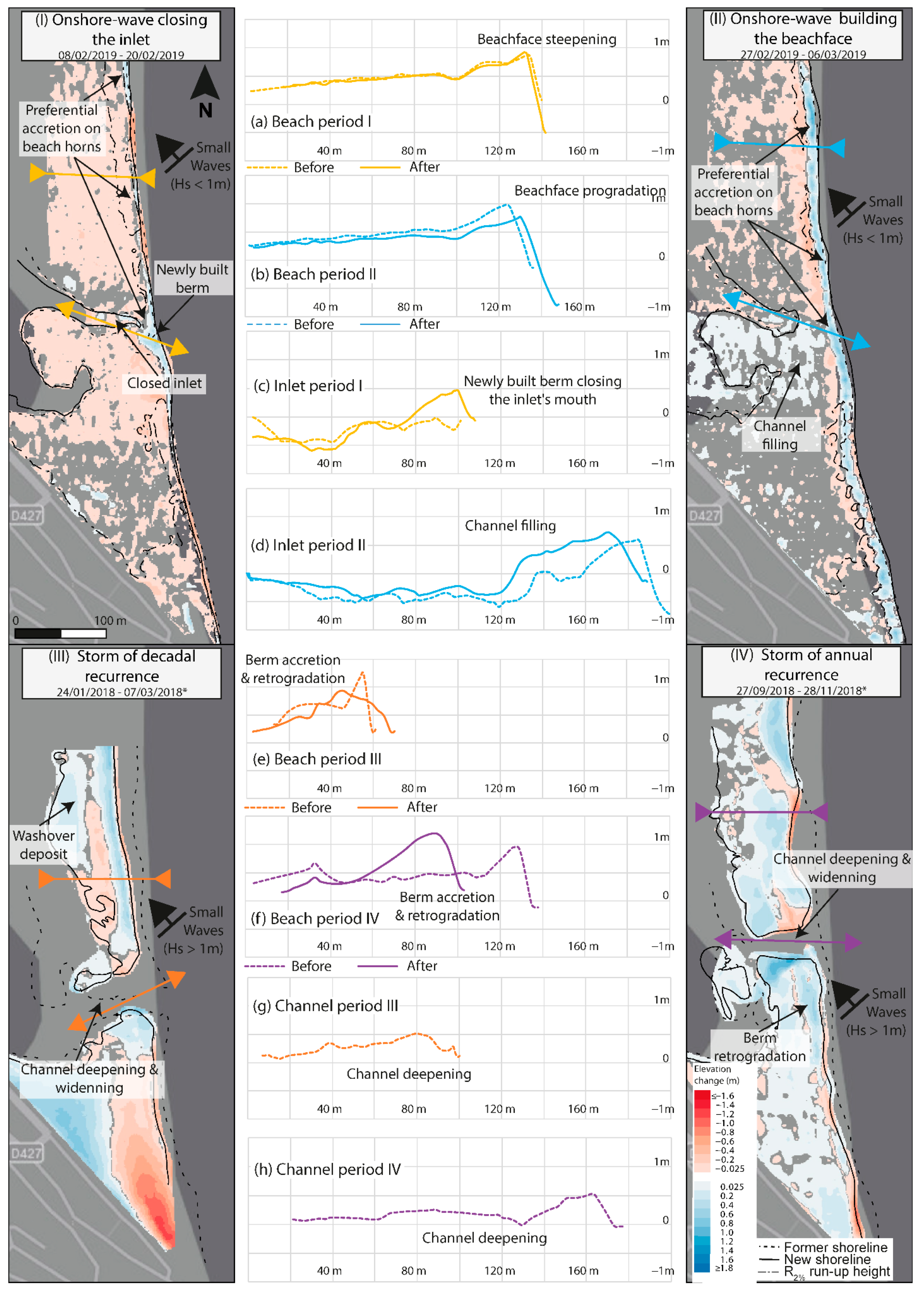

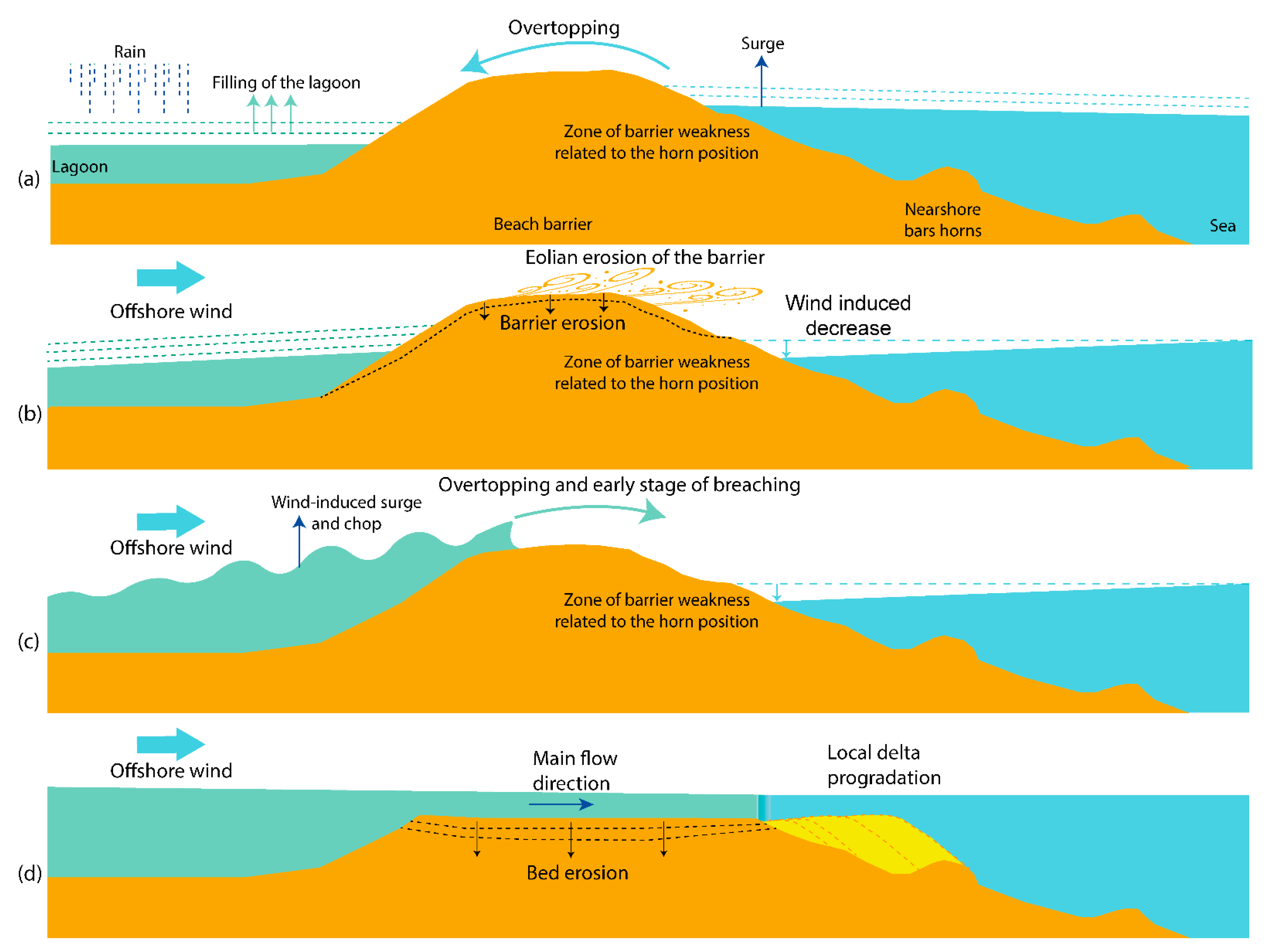
Publisher’s Note: MDPI stays neutral with regard to jurisdictional claims in published maps and institutional affiliations. |
© 2022 by the authors. Licensee MDPI, Basel, Switzerland. This article is an open access article distributed under the terms and conditions of the Creative Commons Attribution (CC BY) license (https://creativecommons.org/licenses/by/4.0/).
Share and Cite
Feyssat, P.; Certain, R.; Robin, N.; Raynal, O.; Aleman, N.; Hebert, B.; Lamy, A.; Barusseau, J.-P. Morphodynamic Behaviour of a Mediterranean Intermittent Estuary with Opening Phases Primarily Dominated by Offshore Winds. J. Mar. Sci. Eng. 2022, 10, 1817. https://doi.org/10.3390/jmse10121817
Feyssat P, Certain R, Robin N, Raynal O, Aleman N, Hebert B, Lamy A, Barusseau J-P. Morphodynamic Behaviour of a Mediterranean Intermittent Estuary with Opening Phases Primarily Dominated by Offshore Winds. Journal of Marine Science and Engineering. 2022; 10(12):1817. https://doi.org/10.3390/jmse10121817
Chicago/Turabian StyleFeyssat, Pierre, Raphaël Certain, Nicolas Robin, Olivier Raynal, Nicolas Aleman, Bertil Hebert, Antoine Lamy, and Jean-Paul Barusseau. 2022. "Morphodynamic Behaviour of a Mediterranean Intermittent Estuary with Opening Phases Primarily Dominated by Offshore Winds" Journal of Marine Science and Engineering 10, no. 12: 1817. https://doi.org/10.3390/jmse10121817
APA StyleFeyssat, P., Certain, R., Robin, N., Raynal, O., Aleman, N., Hebert, B., Lamy, A., & Barusseau, J.-P. (2022). Morphodynamic Behaviour of a Mediterranean Intermittent Estuary with Opening Phases Primarily Dominated by Offshore Winds. Journal of Marine Science and Engineering, 10(12), 1817. https://doi.org/10.3390/jmse10121817






